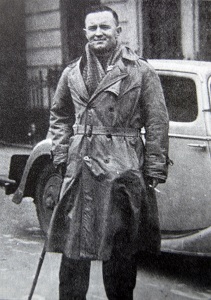LORD HAW-HAW, THE EARLY YEARS

by Tom Kenny
In 1915, a short fair-haired blue-eyed boy was sent to the Jes. He later recalled the staff and the pupils as being tough. Latin was supreme and an excitable Latin teacher banged boys’ heads on the radiator. The Jesuits instilled in him a sense of discipline and an acceptance of punishment, and they left him with a love of language --- his classmates would note how he used big and strange words --- as well as a passion for debate. His uncle Gilbert once remarked “The boy had a strong tendency to argue with his teachers”.
His best subjects were English literature – especially poetry – and languages, specifically Latin, French and German, He played rugby but was clumsy , he was not good at team sports. He developed a passion for chess which he played every day with his friend Myles Webb. He enjoyed the rough and tumble of the playground and had his nose broken in one fight which left him with a nasal tone of voice. He was a gang leader. Some were drawn to his precociousness, bombast and enthusiasm, others found him immature and difficult. His classmate E.L. Kineen recalled “He was a morose and lonely little fellow..... for all his brightness, there was something missing in Willie. He would give impromptu speeches in the playground warning playmates about the growing dangers of communism”.
Perhaps his slightly strained home life meant he had to grow up quicker than other boys. He asked his divinity master whether his mother, to whom he was devoted, was damned for eternity because she was a Protestant. The master told him she was and he said “If my mother is going to hell, then I am going with her” and so he rejected Catholic Doctrine. His master was upset and took him to see the bishop, but they could not change his mind.
He soon found an alternative to religion, politics. He was at an impressionable age after the Rising and during the War of Independence, and he found the fighting, the conspiracies and the intrigues exhilarating. One evening near his house, he found the body of a neighbour, a policeman with a bullet hole in his head. He also saw a Sinn Féiner cornered by police and gunned down. He was fascinated by this.
His father was loyal to the Crown and for Willie, “Patriotism is the highest virtue that i know”, He went to the extreme of volunteering to act as a spy for the Black and Tans. He regularly sat like a mascot in the front of their vehicles as they drove around Galway. An RIC man recalled “He was one of our greatest embarrassments in Galway. His trouble was fanatical patriotism to England and a burning wish to fight against the ‘rebels’ as he called them. He often tried to smuggle himself into our lorries . We laughed at him but if he had been killed or wounded, it would have caused the man in charge of the patrol a lot of trouble”.
Some of his father’s properties were firebombed because he had been helping police. There was a rumour that Willie had informed on Fr. Michael Griffin who was murdered by the Tans. The IRA sent one of their members to shoot Willie on his way home from school, but the family had just moved to another address, Victoria Place. Two days after the Treaty was signed, and the Irish Free State declared, William Joyce was put on a train to Dublin from where he caught the next ship to England.
Our photograph of Joyce was taken in 1939 which features with all of the above information in a book by Nigel Farndale entitled “Haw-Haw, The Tragedy of William and Margaret Joyce” which was published in 2005. It is a fascinating study of a fascinating couple, meticulously researched and beautifully written.
